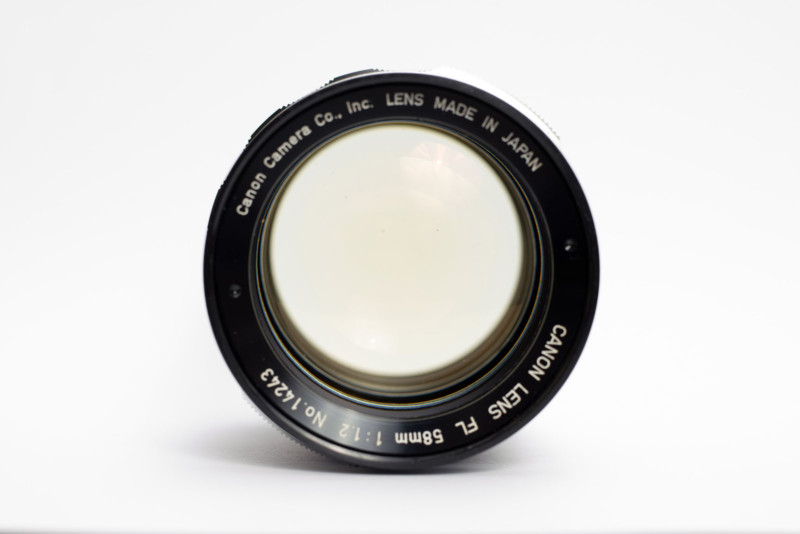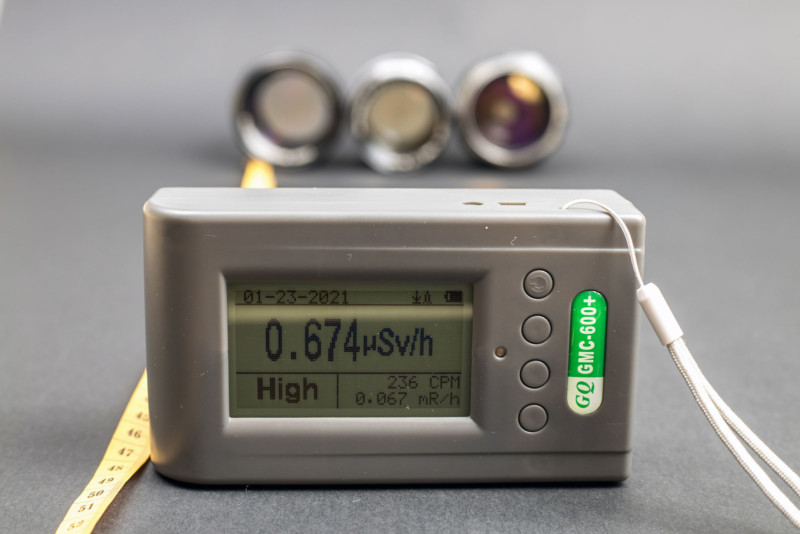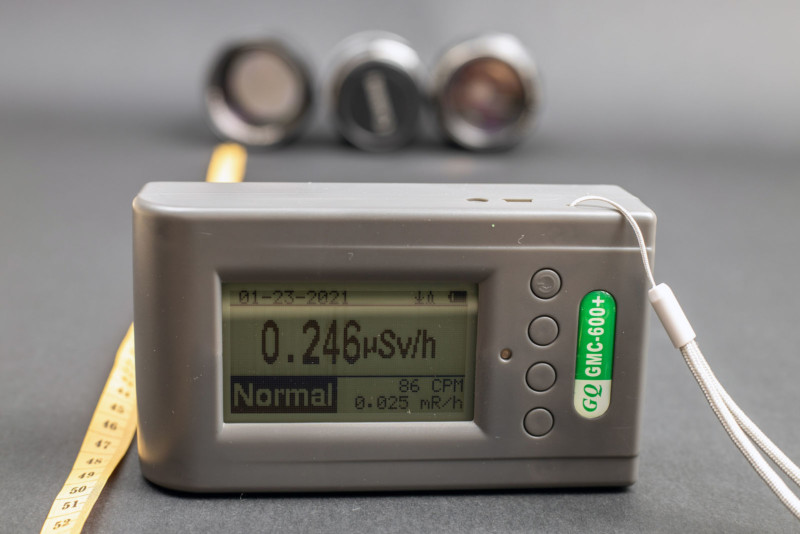
There’s a lot of misinformation about radioactive lenses – from scare stories about growing an extra arm and getting cancer, all the way to saying that radioactive lenses are entirely harmless. The truth is somewhere between the two extremes and requires careful consideration. After all, these lenses contain radioactive substances, and we should treat them with some care.
Like you, I wanted to be safe and understand how to deal with the radioactive lenses. I had so many questions: How to handle them? What damage could they do to me or the camera? Or maybe, I should give them away to a person from the forum offering to “take them away from me” to save me from harm? (Nice try, buddy!)
After reading countless articles, studies, and books, I have compiled the answers to the most common questions.

Disclaimer: This article is purely informational, and should not in no way be used as medical, health, radiation protection, or safety advice, implied or not.
What Makes Vintage Lenses Radioactive?
Thorium and lanthanum, mainly. Camera lenses contain optical glass made with various unusual elements like lead, boron, calcium, lanthanum, and thorium dioxide. These elements have distinct optical properties, allowing manufacturers to create lenses of superior quality.
Both lanthanum and thorium dioxide are radioactive, although radioactivity from lanthanum is so small that it is not detectable without sensitive lab equipment. Lanthanum is only weakly radioactive because only 0.089% of it is lanthanum-138, a radioactive isotope and the remaining 99.9% is non-radioactive lanthanum-139.
Exotic elements such as Thorium, Lanthanum and Zirconium are added to glass mixtures to create the high refractive indexes necessary in sophisticated lens designs. Selection of premium quantities of glass from the large glass pots, stringent spectrophotometric tests after stress and strain checks provide the valuable raw glass for ultimate use in lens elements. —Konica Hexanon Lens Guide, Konica Camera Company, 1972
History of Radioactive Lenses
In 1945, Paul F. De Paolis, from Eastman Kodak Company, filed a United States Patent 2,466,392 for Optical Glass, which introduced thorium and optical glass making properties.
This application relates to glass having optical values in a range that is useful for the designing of optical instruments. Specifically, this application relates to such glass having an index of refraction for the D line (n) in the range between 1.65 and 1.68 and an Abbe value (v) between 52.5 and 57.0.
In general, the glasses herein described are non-silicate and embody as the glassifier boric oxide in an amount between 35 and 40 percent by weight; lanthanum and thorium oxides in substantially equal amounts, greater than ten percent, of each; and barium oxide and either calcium or magnesium oxide. —United States Patent 2,466,392.
Kodak produced some of the first radioactive lenses for aerial surveillance – the Aero-Ektar. Other manufacturers like Canon, Konica, Asahi Pentax, and others also used thorium in their lenses made between about 1945 and 1980.
Manufacturers mostly used thoriated glass for the fastest, more expensive lenses, such as the f/1.2s and f/1.4s, but slower radioactive lenses also exist.
Eventually, by the early 1980s, the thoriated glass fell out of use for consumer lenses – due to the factory workers’ health concerns and consumer radiophobia following nuclear accidents. Newer formulations appeared, offering similar properties without the added risk of radioactivity.
Optical Properties of Thoriated Lenses
The addition of thorium oxide, or thoria, to the glass increases the refractive index while maintaining low dispersion. These properties are especially beneficial for making optical glass.
A high index of refraction means light travels slower within the glass, and therefore, changes its direction more easily. Lenses can have a lower profile, require less material and thus be lighter.
Low dispersion, defined by Abbe number, allows lenses to correct chromatic aberration, ensuring the same focus is maintained throughout the whole range of colors in the visible spectrum, creating sharper images.
Combining these properties allows for lenses with excellent optical performance.
What is Thorium?
Thorium is a weakly radioactive metallic chemical element with the symbol Th and atomic number 90. All known thorium isotopes are unstable. The most stable isotope, 232Th, has a half-life of 14.05 billion years, or about the age of the universe. It decays very slowly via alpha decay, starting a decay chain named the thorium series that ends at stable 208Pb. —Wikipedia
Thorium is a naturally occurring, most abundant radioactive element in the earth’s crust. Thorium is relatively stable and has a half-life of 14 billion years.
Do Radioactive Lenses Emit Only Alpha Particles?
Not really. While it’s true that pure thorium decays by emitting an alpha particle as stated above, this is only the start of the long series of decays that emit alpha, beta, and gamma radiation until it ends with the stable isotope of lead. You can read it as such:
Thorium 232 -> releases alpha α -> becomes Radium 228, then
Radium 228 -> releases beta β- -> becomes Actinium 228, and so on.

The above decay chain demonstrates that thoriated lenses contain thorium and its daughter elements: radium, actinium, radon, polonium, bismuth, thallium, and lead in minute quantities, resulting from slow thorium decay.
What Is Bremsstrahlung Radiation?
When beta particles slow down within denser materials, such as the barrel surrounding the lens, they create electromagnetic radiation by releasing a photon – an x-ray or gamma-ray. This secondary radiation is called “bremsstrahlung“, German for “braking radiation”.
Most vintage lens barrels are steel, copper, or aluminum and produce tiny amounts of secondary gamma radiation. The heavier the shielding material, the more bremsstrahlung radiation is emitted.
Due to how little beta decay there is, the resulting bremsstrahlung radiation is also minimal. Still, it’s worth mentioning for completeness to understand what types of radiation you could expect from a lens.
Dangers of Radioactive Lenses
Glass dust and fine particles
Elements in the thorium decay chain are incredibly toxic and dangerous on their own and in larger quantities. However, the amounts present in the lenses are tiny and only exist for a short time.
Breaking the lens will not “release” the radiation or the toxic elements which remain in the glass lattice structure. Nonetheless, it will contaminate the premises and make it easier to ingest or inhale small bits of radioactive dust.
Alpha particles can only penetrate a few micrometers of the outer layers of human skin and are harmless – as long as they are outside the body.
Alpha-emitting particles are significantly more dangerous inside the body. Ionizing properties of the alpha particles cause damage when they are close to the cells — specifically, those in the respiratory tract and lungs and the digestive tract, stomach, and intestines.
Ensure you do not smash, grind, scratch, or scrape the lens elements to avoid getting radioactive particles inside the body. As a good measure, I also wash my hands after handling them.

Eye damage from radioactive lenses
For uses of thoriated optical glass that are authorized under this exemption, the lens would be enclosed by other materials or there would be additional material between the lens and the tissues of an exposed individual, and only photon exposures would be of concern. However, in unauthorized uses of thoriated optical glass, such as eyepieces of optical instruments, exposure to the eye to alpha and beta particles also would be of concern. This concern is because of the proximity of the glass to the eye and lack of sufficient absorbing material between the source and tissues of the eye. —nrc.gov NUREG-1717 Page 3–288
Increased radiation exposure can cause cataracts in the eyes, therefore avoid needlessly exposing your eyes – wear glasses and don’t put radioactive lenses close to the naked eye when cleaning or handling them.

Testing showed that simple eyeglasses effectively shield radiation emitted from the lens – only one-tenth of the radiation gets through. I measured approximately 3006 CPM through glasses versus approximately 28000 CPM at the surface.



Radiation exposure from radioactive lenses
According to the research (below), radioactive lenses are relatively safe. We are regularly exposed to radiation from various sources every day, which combined give a more significant dose than the use of radioactive lenses would:
- Walking around outside in the sun (main contribution to the annual radiation dose)
- Staying at home (Radon from the building materials, tiles)
- Eating bananas (Contains potassium-40)
- Eating brazil nuts (Contains Radium-226)
- Flying on an aeroplane (about 2μSv/h of Cosmic radiation)
- Getting an x-ray at the doctor
- Sleeping next to someone (the other person is radioactive to us (potassium-40)
- Having a smoke detector (contains americium-241)
- Having a granite countertop (uranium and decay products)
- Smoking (releases radium, lead-210, polonium-210)
The total gamma energy released every second from the Carl Zeiss Tessar, on the other hand, was almost 32 MeV/s. The contribution from this for a photographer to the maximum annual dose to the whole body was calculated to be just 0.17 ‰. This is comparable to the increased dose from beta radiation. Thereby the beta and gamma radiation from the Carl Zeiss Tessar are equally non-hazardous. These ratios are so close to zero that the conclusion drawn in this thesis is that there are no radiation-related health hazards involved in the usage of any of the camera lenses measured. —An Analysis of Residual Radiation in Thoriated Camera Lenses. Jonathan Wäng and Viktor Henningsson, 2013.
How to Identify Radioactive Lenses?
The most reliable way to determine whether the lens is radioactive is by measuring it with a Geiger counter. However, few people have easy access to one, and in that case, a visual inspection could be used as a backup.
Visual inspection can reveal hints that the lens is radioactive – radiation over time causes yellowing of the lens elements. However, aging, as well as the composition of the glass, can also cause discoloration of the glass.
Looking through the lens at a white sheet of paper reveals the elements’ yellowing compared to the surrounding white paper. A significant difference in tone indicates a higher chance that the lens is radioactive. On the other hand, clear glass does not mean that the lens does not contain radioactive materials – it can go both ways. Radioactive lenses lose their yellow tint when exposed to UV light.


Is Lens Coating Radioactive?
Lens coatings come in a variety of colors, which may appear yellow when viewed from an angle. The coating color is not related to lens radioactivity and can be of any color for radioactive, and non-radioactive lenses.
Some sources incorrectly state that the lens coatings are radioactive – that is not the case. The actual glass contains thorium – not the coatings. For example, Mamiya uses yellowish coatings on most of their vintage lenses, while only some of those lenses are radioactive.
Why Do Radioactive Lenses Yellow Over Time?
Radiation creates F-centers in the glass because radioactive decay displaces electrons, which cause the glass to take a yellow or brown tint.
UV light can clear some of the yellowing. It may take up to 7 days of exposure to the sun, or UV light sources to lessen the yellowing. However, I like the warm color cast in my photos, and leave the lenses as they are – it is a unique “feature” of a thoriated lens.
How to Store Radioactive Lenses?
To avoid elevated radiation exposure – store the radioactive lenses as far away from yourself as reasonably possible. If you have a choice, do not keep them in the bedroom or locations where they are close to humans for prolonged periods. Even though the exposures are small, they all add up over time.
I measured a drop of radiation readings to background levels at about 1-1.5 meters away from the lenses.
An aluminum case is a good option because it is a good shielding material for alphas and betas. Nevertheless, storage container material does not make as much of a difference in the dose rates as distance, so if you are worried – increase the distance between yourself and the lenses.


Measurement Equipment
I measure my lenses using GQ GMC 600+ and GQ GMC 300E+ Geiger-Muller counters. GQ GMC 300E+ uses a more common M4011 GM tube, which is not very sensitive to Alpha radiation but detects Beta and Gamma. Meanwhile, the GMC 600+ uses LND 7317 pancake GM tube and is very sensitive to all types of radiation.
Do Radioactive Lenses Damage Cameras?
All electronics are susceptible to radiation damage to some degree – digital cameras suffer from the formation of hot pixels on the sensor.
A simple test shows how radiation might affect the camera sensor. After 90 seconds of exposure with a lens cap, a radioactive lens left visible “excited pixels” in the image. That is where the high-intensity particles hit the sensor. The pixels returned to normal for the next frame, and were not “stuck”, but I think it’s a good idea to remove radioactive lenses from the camera body and be on the safe side.
More information about hot pixels can be found on Hubble telescope camera, CMOS image sensors, and Reddit.
Posting Radioactive Lenses
Radioactive lenses do not usually cause problems for posting. I had various lenses shipped without any trouble, except from one time, when a Mamiya Sekor 55mm f/1.4 was being shipped from the USA using the eBay Global Shipping program. Global Shipping sent the lens back to the seller with a note stating that radioactive materials are not permitted.

Are Radioactive Lenses Still Being Made?
Current consumer lenses do not contain thorium – it has been replaced with newer formulations of glass, avoiding the radioactivity problem. The main concern was the factory workers’ health – nobody would want to polish and grind the glass and expose themselves to radiation. Also, people’s fear of radiation makes the finished product challenging to sell.
Interestingly, thorium is still used by the United States military, in the state-of-the-art Global Hawk drones.
On June 21, 2017, a U.S. Air Force RQ-4 Global Hawk crashed near Mt. Whitney, which lies on the boundary between Sequoia National Park and the Inyo National Forest in California. It’s rugged, heavily forested terrain, and now the service wants someone to go in there and recover parts of the drone.”
“Thorium is a radioactive material and decays through alpha emission. If the lens has been burned or it has been melted the potential for alpha radiation exposure is higher. —TheDrive
The aircraft also has an optical lens which is impregnated with Thorium to enhance optical properties (similar to many commercial optics) —The contract document
If the United States military chooses to use thorium to power their drone optics, perhaps we can say that it is still the best glass when absolute quality is required?
Are Radioactive Lenses Better?
Some of the most excellent vintage lenses ever made are radioactive. Is thorium to “blame” for their success, or is this only a coincidence? Difficult to say, but the fact that thoriated lenses are used in top-quality optical systems of military drones suggests the former.
I tested quite a few radioactive lenses and fell in love with them. The Mamiya 58mm f/1.7 shows exceptional optical performance – images are sharp and contrasty with striking warm colour.
I am yet to find an optically poor example of a radioactive lens – quite the contrary – they are all excellent.
Modern non-radioactive lenses surpass these vintage lenses in absolute sharpness and contrast. Furthermore, they usually feature more complex designs, with more elements and groups. However, the optical properties of the vintage lenses are more pleasing to some people – including me.
About the author: Mantas Kalausis is the photographer behind the website Lens Legend, a website about vintage and modern lenses with everything from sample photos to reviews. The opinions expressed in this article are solely those of the author. You can find more of Kalausis’ work on his website, Facebook, Twitter, and Instagram. This article was also published here.